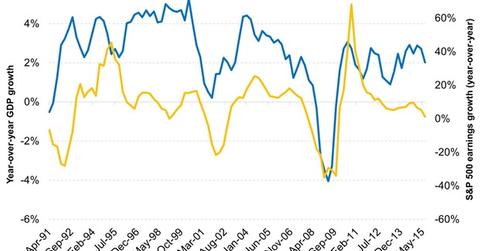What’s the Biggest Driver of Earnings Growth?
Economic growth is the biggest driver of earnings growth. Earnings growth seems to follow the same trajectory of GDP growth.
Nov. 5 2015, Published 2:39 p.m. ET

The Evolution of Profit Recessions
Looking back at history, profit recessions—defined as at least two quarters of consecutive negative earnings growth—typically accompany economic recessions. This shouldn’t come as a surprise. Historically, the biggest determinant of earnings growth is revenue growth, which is a function of economic growth. Put differently, what’s happening in the real economy trumps other factors impacting profits, such as changes in margins.
The importance of economic growth for corporate profitability is evident when looking back at over 60 years of National Economic Accounts corporate profits data. Over the past sixty years, quarterly changes in real gross domestic product explain roughly 30 percent of the variance in quarterly profits growth.
Given this relationship, in the absence of an economic recession, how are we in a profit recession?
Market Realist – Economic growth is the biggest driver of earnings growth.
The above graph compares the year-over-year (or YoY) growth in US GDP (gross domestic product) with the YoY growth in the earnings of S&P 500 (IVV) (VOO) companies over the last 25 years. As you can see, earnings growth seems to follow the same trajectory of GDP growth. The correlation between the YoY growth in the two in that period is +0.52. However, earnings growth seems to be more volatile.
In the previous economic recession in the late 2000s, earnings growth plunged into the negative territory as well. This time around, though, while US GDP growth seems solid though uninspiring, corporate earnings have slumped into a technical recession.
In 3Q15, there are more companies beating earnings estimates, but few are beating sales estimates. This means that companies are cutting costs in order to improve earnings. Of the 340 S&P 500 companies (SPLV) that have reported earnings through October 30, 76% reported actual EPS (earnings per share) above the mean EPS estimate, while 47% reported actual sales above estimated sales, according to Fact Set.
Telecom, healthcare (XLV) (IYH), and consumer discretionary (VCR) have been the best-performing sectors. Energy (IYE) (XLE) has been by far the worst performing sector due to plunging oil (BNO) prices.
Read on to find out why there’s a profit recession in the absence of an economic recession.
